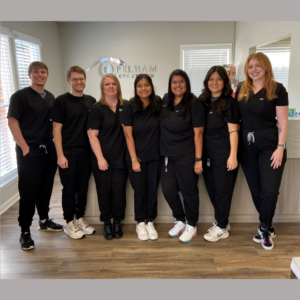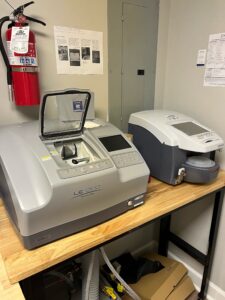
The team at Pelham Eye Center. Dr. Williams says that she and her partners have made a few key investments that have been highly beneficial to both patients and practice profitability.
By Jennifer Williams, OD
March 1, 2023
We started an independent optometry office in January 2020 after a private equity group acquired our previous location. That meant that over the last three years we have been looking for ways to enhance care while building profitability in our new practice.
Here are a few investments that are improving care for our patients while helping us to generate significant revenue.
Wide-Field Imaging
Once we reached our six-month mark in business, we decided to purchase an Optos optomap retinal imaging system that would replace our standard fundus camera. We wanted to be able to offer our patients the best technology, and many of our patients were familiar with optomap technology since they had widefield retinal imaging done in the past. In order to offer our patients that same “wow factor” at our new office, we decided to make the investment to implement the same technology in our new office.
Editor’s Note: There are other many wide-field imaging technologies to choose from. Other options include the ZEISS Clarus 500, Topcon Maestro2, Visionix Optovue Avanti and the EIDON Ultra-Widefield Module from iCare, among others.
The initial purchase price for this equipment was around $90,000, which we financed over five years. The monthly payment is around $1,800. We charge a retinal imaging screening fee to patients for this service, and the response has been overwhelmingly positive. Our capture rate is around 80-85 percent. We also use the optomap for medical fundus photography and bill medical insurance for the photos when medically necessary.
Our optomap paid for itself within the first year. We have a heavy medical patient base, so billing for medical fundus photography further added to our profitability. The camera generated about $120,000 in revenue from screening photos and medical fundus photography combined last year, and we expect this number to be higher in subsequent years as our practice continues to grow.
Patients really love this equipment. We view and explain the images with patients in the exam room. When pathology is present, we are able to show patients the problem, which helps them gain a better understanding of their overall eye health. We don’t use the optomap in place of dilation, but if patients cannot be dilated or refuse dilation, it’s nice to still be able to get good retinal views. This is a great service to offer patients and a really good way to increase revenue to supplement stagnant reimbursements from standard vision insurance plans.
The optomap technology has been a substantial practice-builder. As repeat patients come back each year, they are still willing to pay for this technology, and they are excited when we show them their subsequent retinal images, especially when we are monitoring pathology and can show them images side-by-side. We initially hesitated to purchase the optomap because of the high price point, but we are so glad we made the investment and are proud to offer our patients this technology.

The addition of the above lens edger to Dr. Williams’ office has improved service for patients and is generating impressive ROI.
In-Office Lens Finishing
In-office lens finishing was the second type of equipment that took our practice to the next level. After about 18 months in business, we purchased the Santinelli ICE-1500 tracer/blocker and LE-1200 edger after demoing those units at an optometry conference. We wanted to be able to offer our patients in-office finishing to increase turnaround time on glasses and provide better customer service.
Not many other practices in our area have an on-site finishing lab, so this helped set us apart. Patients cannot believe it when their glasses are ready same-day or next-day. Not only has this equipment increased sales, patient loyalty and word-of-mouth referrals; it has also saved us money on our lab bill.
Editor’s Note: There are many lens edgers to choose from. Other options include those from Visionix, Essilor and Coburn Technologies, among others.
Our initial investment for the blocker and edger system was around $45,000. We financed the equipment over a three-year period. Our lens vendor was able to offer us ongoing quarterly rebates, which offset the cost of this equipment. It will easily pay for itself within the first year. Our monthly payments are approximately $1,100, but we save about that much on our lab bill each month. This equipment should generate anywhere from $30,000 to $40,000 per year.
Other Articles to Explore
Santinelli provided in-office installation and training, and we were fully functional with the equipment from the first day. We stock single vision, polycarbonate, anti-reflective and/or blue-light blocking lenses in our office in a wide range of powers. Our opticians have dedicated time each day to work on jobs.
Although this equipment will add to our profitability over time, our motivation for in-office finishing was more about customer service than revenue. Patients have been impressed that we can edge lenses so quickly, and that has led to increased sales and referrals. We no longer have to send frames to the lab when patients want lenses for their own frames—we can cut lenses same-day or next-day in most cases!
We are about to enter our third year in business, and we have several other pieces of equipment we will be implementing over the next few years; however, these two purchases have definitely paid for themselves and have been crucial to helping our practice grow.
 Jennifer Williams, OD, is a partner with Pelham Eye Center in Pelham, Ala. To contact her: jenn@pelhameyecenter.com
Jennifer Williams, OD, is a partner with Pelham Eye Center in Pelham, Ala. To contact her: jenn@pelhameyecenter.com





















